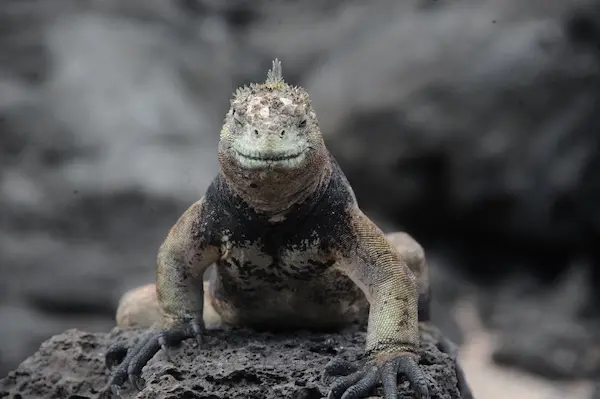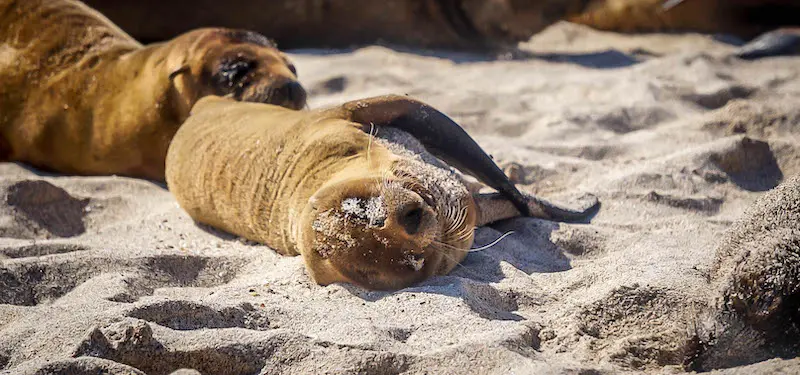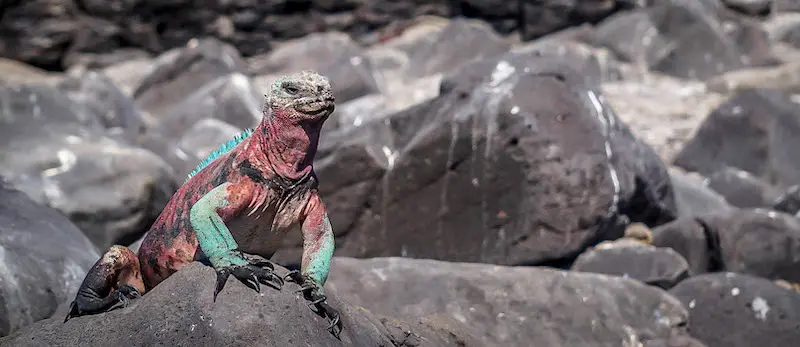Travel insights from Latin America
Treading Carefully in the Galapagos

| The Galapagos is among the most fragile archipelagos on earth. Kagumu founder Simon Willis, discovers the importance of protecting its ecosystems while coming face-to-face with evolution. |
I tiptoe toward an iguana and flick on my camera. As I kneel down on a warm volcanic rock its beady eyes shift onto me.
“Stop!” someone shouts. My guide Orlando strides toward me.
“Get back on the trail,” he yells. “There could be a nest close to you. If we destroy the eggs, we damage the whole ecosystem.”
It’s mid-January and we’re on South Plaza Island – the sixth stop on a seven-day cruise around the Galapagos, an archipelago with the most extraordinary yet fragile ecosystems on earth.
Just over 10 years ago this group of islands, lying 1,000km off the coast of Ecuador, was so close to disaster that it sat on UNESCO’s endangered list. Today, with the islands off the list, I’m here to discover what’s protecting them. I also want to leave without falling into a rare plant and causing irreparable damage to the environment.
Our guide, Orlando Romero, knows more about preserving the Galapagos than most. In 1975 he, along with two other naturalists, marked out the first tourist trail here, and 76 elsewhere in the archipelago.
An first-hand look at wildlife in action
After ensuring I’m back onto the trail, he leads the 10 of us along the rocky terrain.
At just 13 hectares, South Plaza is one of the smallest islands in the archipelago. It has a sea-level shore at one side and steep cliffs at the other.
Alongside the trail, red Galapagos carpetweed (Sesuvium) spreads over the surface, wrapping around black rocks. Seven-ft.-tall prickly pear cactuses sprout up in clusters, their sharp needles protruding out of disc-shaped branches.
A single brown feather sticks to one branch. On the floor, a bunch of feathers, and a few more a meter away. The trail is covered with them; many with bony limbs attached.
“Owls!” Orlando says, turning to face us. “Probably the short-eared owl. It hunts storm petrels and other small birds.”
He grabs two yellow sun sleeves from his pocket and pulls them over his red arms, “Actually this looks like it could be recent. Could be last night even.”
Orlando walks on as we photograph the dismembered remains like forensics at a murder scene.
Such massacres are rare in the Galapagos. A lack of predators means wildlife is incredibly tame, allowing you close enough to feel the salt water spray from sneezing marine iguanas, or hear the pitter patter of the blue-footed booby as it performs its mating dance.
The Galapagos sea lion is no exception. About 50,000 live on the islands and 1,000 on South Plaza. Along with the ones slinking through the clear blue water, growling as they bob their heads up, and others lying next to each other spooning, there’s a corner of the island inhabited by just one gender.

“This is the bachelor colony,” Orlando shouts, as a wave explodes like a grenade behind him.
“When the male loses the fight for territory and a female he comes here to recover.”
Orlando points down the cliff where waves are smashing against rocks then hissing on retreat. “They climb from the ocean up this way,” he shouts. “Then they stay until they have the energy to return to find another mate.”
We peer over the edge. The sea spray sprinkles our cheeks.
“Look here,” Orlando points to a black sea lion, about 6ft long, lying on the rocks. “This is one male who lost the fight; he’ll be here for about a month, resting and waiting. It’s like…”
Before he can continue we are joined by the other group led by Ivan – a guide, mid-30s with strap-round sunglasses, trimmed beard and tree-trunk legs.
“It’s like a bar saloon,” Ivan says. “The males come here to, you know drink beer, play cards, smoke a cigar. There’s no pain here. It’s like no woman no cry.”
He stamps his foot on the gravel and salutes Orlando. “Isn’t that right comandante – commander!
“Of course,” Orlando says.
They shake hands as we take photos of the jilted sea lion.
I zoom in on flies bombarding his whiskery snout. These merciless insects attack his open wounds and closed sandy eyelids. My own eyes trickle from the stench of nearby poop. I ponder whether such a state of female rejection is worse than lying in bed weeping to Coldplay.
A glimpse into evolution
Before I can decide, Orlando waves us away. He leads us along the coast, picking up a rock and moving it to one side, like a fastidious gardener pruning his backyard.
He looks back, making sure we haven’t wandered off trail or are sitting on a lizard. Even giving water to animals is banned. They would become dependent and may neglect their natural drinking pattern.
Orlando stands on a stack of rocks; one rucksack strap hanging off his shoulder, white chest hair exploding out from his collar.
“For me the most important animal here is the marine iguana,” he says, “They are the symbol of the Galapagos because of how they’ve evolved.”

Every rock around is covered with these scaly black reptiles. Some lie, soaking up heat from the surface; others sit behind rocks, their front claws clinging to the top.
“In general wildlife came out of the water, but in this case it went back in,” Orlando says pointing to a marine iguana next to a blotchy yellow land iguana.
“We think they arrived about 10 million years ago. Then the ones living on islands with no food began to swim. Can you see the marine iguana has a much longer tail? This means it can swim more easily.”
I squat down to the two reptiles.
“You can see the marine iguana has a more flat face,” Orlando says, “This helps it eat algae from the rocks in the sea.”
Before arriving in the Galapagos, I attempted to read “On the Origin of Species” – Charles Darwin’s theory of evolution derived from his visit in 1835. This book is said to be one of the most important works in human existence. While this may be true, it’s a notoriously “tough” read and as I speak my bookmark separates pages 13 and 14.
Of course, the islands have changed slightly since Darwin arrived on the H.M.S Beagle.
Protecting the future of the Galapagos
In 2007 the Galapagos were in such a mess that a UN panel voted for UNESCO to list it as endangered; citing overpopulation, uncontrolled tourism and threatening invasive species as the main reasons.
Today, however, 97 per cent of the islands are protected by the National Park and visitor numbers are restricted annually to 180,000, 100 per day on most islands. Visitors are searched for hazardous materials and all bags are scanned, then sprayed with pesticide. Threatening species are ‘eradicated’ by various means. Orlando, who shot goats on the islands in the 70s, revealed spots on South Plaza Island where poison is placed to kill rats (a species that munch on bird and reptile eggs).
Thanks to these efforts UNESCO removed the Galapagos from the “red list” in 2010 – a decision that must have pleased Orlando.
“Not really,” he says. He lifts his floppy sun hat and wipes his brow with a handkerchief. “It should be on the list because not everything is working well.”
In the distance, a speed boat approaches ready to take us back to our cruise ship, then on to the next island.
“The main problem is the 35,000 people who live here,” Orlando says. “There are no regulations on what they do, and what animals they bring.”
The speed boat bounces into the landing dock, gargling and spitting water from its rear. A man steps off with a huge sack of life jackets.
“They have relatives,” Orlando says, “who come to the islands and stay, and then they have children. Imagine how many more people will be here in the next few years.
“The restriction of tourists is good, but if this increases it could be difficult to regulate.
“Galapagos is part of my life. We must preserve this ecosystem, not destroy it.”
I grab a life jacket from the bag, wrap it round my torso and clip in the buckle.
Orlando leads us across the final section of his trail.
Although South Plaza doesn’t have the cream cashmere sands of Gardner Bay on Espanola, or the sea-turtle snorkeling at Devil’s Crown near Floreana, it’s shown me a side of wildlife no book, lecture or documentary could ever do.
Maybe more importantly, I haven’t squished a lizard, or fallen into a nest of iguana eggs. My footprint has left with me. Whether Orlando’s trails can protect the islands during the inevitable increase in tourism and population is another question.
Interested in following in Simon’s footsteps, check out Kagumu’s Galapagos educational tour here.
